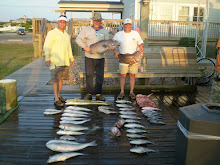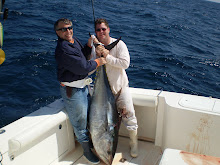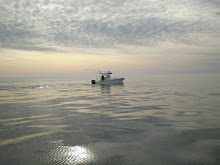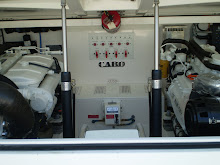
Last week the Washington Post carried a story that confirms--yet again--the enormous amount of poaching that occurs and endangers the existence of already-depleted fish stocks. This time we return (surprise, surprise) to striper poaching in the northern Chesapeake Bay, at the southern tip of Kent Island, in the shallows near Bloody Point Bar Lighthouse. The thieves employed submerged gill nets, which are approved for taking strippers, but only when properly tended, used on defined dates, and in compliance with catch limits. In this case, however, the poachers caught 20,000 pounds against a daily legal quota of 300 pounds--stealing the equivalent of 66 days of legal netting from their fellow watermen. In reaction, state officials were so stunned by the size of the illegal catch that they immediately closed down the gill net fishery, which was projected to stay open through the end of February. Just to give you a sense of the magnitude of the heist, an icebreaker with a huge winch had to be called in to retrieve the illegal net from the water.
And we wonder why spring-time striper fishing in the Chesapeake Flats is dead--obviously, because fewer and fewer fish survive a treacherous passage from the ocean to their native spawning grounds, having to make it through a gauntlet of legal and illegal fishermen numbered in the thousands. In contrast to quotas set by fisheries officials, the actual number of stripers killed each year is at least 2x the official limit. When will the fishing community wake up to the scale of poaching and its devastation on the wildlife and sportfishing community? When will ethical fishermen wake up and smoke out the bandits? Personally, I think people are actually getting sick of this type of crime, and things will turn against these bums. Hope I'm directionally right--for the fish.
See below for two articles on the poaching incidents, as well as a variety of photographs.
Map of the area: Annapolis at left, Chesapeake Bay bridge in green, Kent Island at right, Bloody Point Bar at the very southern tip of Kent Island

Bloody Point Bar Lighthouse today, erected in 1882


Police discover 10 tons of illegally caught rockfish in Chesapeake Bay
By Darryl Fears
Washington Post Staff Writer
Friday, February 4, 2011
Ten tons of rockfish were caught this week in the Chesapeake Bay, where the legal limit is 300 pounds a day.
It was a staggeringly high illegal fish kill in a short period of time, and on Friday Maryland officials announced aggressive steps to stop it.
Step 1: Shut down the February season for rockfish fishing with lethal gill nets.
Step 2: Offer a $7,000 reward to anyone who can help put the poachers in jail.
Step 3: Tightly enforce the quota system for fish catches.
"We seized over 20,000 pounds. That means these poachers are stealing 66 days of work from watermen," said Tom O'Connell, fisheries service director at the Maryland Department of Natural Resources.
State police who patrol the bay and its tributaries announced Tuesday the discovery of a poacher's gill net containing three tons of rockfish near Bloody Point Lighthouse, between Queen Anne's and Talbot counties. The largest catch uncovered by a lone patrol in at least 25 years was so big that an icebreaker was called in to haul it.
But Wednesday and Thursday, police in boats came upon more sunken gill nets, also in the vicinity of the isolated lighthouse, with illegal catches totaling seven tons. Under law, gill nets must be monitored by fishermen and must flow with the tide rather than be anchored.
Rockfish, also known as striped bass, and blue crabs have virtually disappeared in the past before being restored.
The clam population is currently low.
"The people of Maryland have invested far too much time, effort and money into restoring striped bass, our state fish," said Secretary of Natural Resources John R. Griffin.
Anyone with information about these crimes is asked to call the department's Catch-a-Poacher Hotline at 800-635-6124.

Illegal Striped Bass Seizure Spurs Shut Down of February Gill Net Season. DNR, stakeholders offer reward for information leading to rockfish poachers' arrest
Annapolis, Md. (February 4, 2011) — The Maryland Department of Natural Resources (DNR) has shut down the February striped bass gill net season after Natural Resources Police (NRP) confiscated more than 10 tons of illegally caught striped bass in two days. NRP seized the 20,016 pounds of rockfish from four illegally anchored gill nets found near Bloody Point Light, south of Kent Island in the Chesapeake Bay.
“Wanton illegal behavior cannot, will not be tolerated,” said Secretary John Griffin. “The people of Maryland have invested far too much time, effort and money into restoring striped bass, our State fish. These poachers are stealing from every Maryland citizen... including from our honest, hardworking watermen who follow the law. I particularly want to commend our dedicated Natural Resources Police officers, many of whom staked out the sites overnight, during terrible weather conditions."
Maryland’s commercial striped bass fishery is managed on a quota system, in cooperation with the Atlantic States Marine Fisheries Commission; the commercial gill net quota for February is 354,318 pounds. When the illegally harvested striped bass confiscated by the NRP were deducted from the quota, DNR was forced to immediately shut down the fishery. The fishery will remain closed until DNR can determine the extent of illegal nets out on the Bay and the amount of striped bass caught in those nets.
“Watermen are allowed to catch about 300 pounds of rockfish per day. We seized 20,000 pounds. That means these poachers are stealing 66 days of work from honest watermen,” said DNR Fisheries Service Director Tom O’Connell.
The State, along with the Coastal Conservation Association (CCA), The Maryland Watermen’s Association, the Maryland Saltwater Sportfishermen’s Association and the Maryland Charter Boat Association, is offering a reward of more than $7,000 for information that leads to the arrest and conviction of a person or persons responsible for setting these anchored gill nets in the vicinity of Bloody Point Light. Funding for the reward will come from dedicated funding as well as contributions from these stakeholder groups, who are publicly denouncing these crimes.
“Today’s announcement demonstrates that illegal fishing that steals the resource from all Marylanders will not be tolerated,” said CCA Maryland Executive Director Tony Friedrich. “We look forward to working with the Department and other stakeholders to insure that the penalties for these types of crimes are strengthened and those responsible are held fully accountable.”
“The Maryland Watermen’s Association is here to protect the honest fisherman,” said Association President Larry Simns. “We’d like to do anything in our power to catch the person responsible for this and we’d hope they’d lose their license.”
“The Maryland Saltwater Sportfishermen's Association is extremely disheartened and outraged over the events of the past several days,” said Executive Director Dave Smith. “This type of flagrant disregard for the law and our vital resource must end. The MSSA is working with the Department and other stakeholder groups to put in place deterrents and meaningful consequences for these types of crimes.”
The NRP found the first anchored gill net on Monday, January 31 at 2 p.m., the day before the February striped bass gill net season opened. Officers began a surveillance detail and after 17 hours without activity officers pulled up the net, which was full of rockfish. Officers continued pulling the net and offloading the fish until 9 p.m., when 6,121 pounds of fish were taken out of the 900 yards of illegal anchored gill net; 400 pounds were given to state biologists for use in an expanded gender sampling survey, and 5,721 pounds were sold.
Officers located another net at about 9 p.m. near the first net and began to pull it up immediately. NRP continued to load the net and fish into patrol boats throughout the night. While loading the second net, officers found two additional nets. The NRP worked until 5 p.m. Wednesday evening, landing an additional 13,895 pounds of illegally caught fish.
Officers also recovered 2,100 yards of anchored gill net from the Choptank River on Sunday, January 30, and 100 yards of anchored gill net from the mouth of the Chester River on Thursday. These nets had a few fish that were released alive.
Information on this crime may be called into the Natural Resources Police Catch-a-Poacher Hotline at 800-635-6124. Callers may remain anonymous.
Net and dead stripers on deck of the icebreaker




Poached fish from additional gill nets in patrol boats











I enjoyed reading the article above, really very interesting and effective. Thank you for sharing this gill net fishing article.
ReplyDeleteFirst time reading this thanks for sharing
ReplyDelete